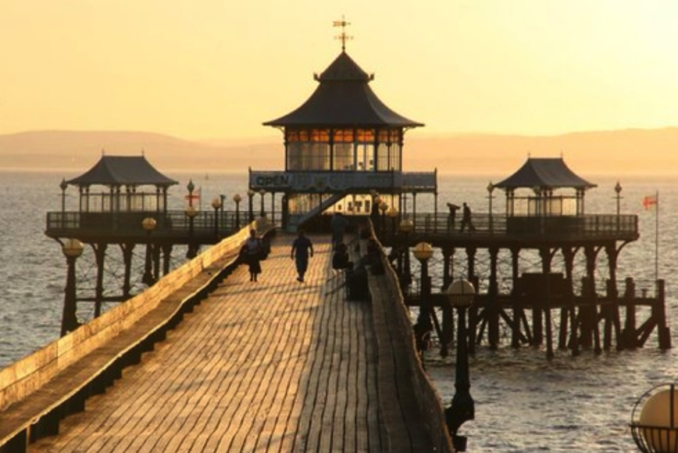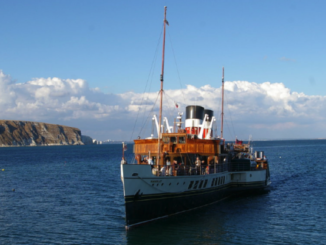Clevedon is a small town in North Somerset, located on the English side of the Bristol Channel approximately 15 miles west of Bristol. It has a wonderful pier with an interesting history which I thought would make the basis of an article for GP.
I have a number of early childhood memories of visiting the beach in Clevedon in the 1970s and looking across to the pier, which at that time was closed due to a partial collapse of two of the spans following testing carried out in October 1970 for insurance purposes. I never imagined then it would ever reopen.
Early History and Construction
The Clevedon Pier Company was formed in late 1866 and issued a prospectus inviting investors to purchase shares in the company which had plans to build a pier attracting tourists to the town and providing a ferry port for rail passengers to South Wales. At that time Clevedon was a popular seaside bathing town with good railway links capable of bringing large numbers of visitors to take in the saltwater baths there. It was proposed that a pier could form part of a railway route from London to South Wales with the use of steamers to cross the Severn Estuary.
Construction work commenced in 1867 using discarded wrought iron railway lines formed into eight 100 ft arched spans standing on trestles of the same material and wood planks for decking. By August 1868 six hundred feet of the pier had been built and the final section was completed in February 1869 with the pier officially opening on 29th March.
In 1893 the pier head was replaced in cast iron with a new timber landing stage, and the pier head pavilion was completed in 1894.

Clevedon Pier,
Alison Day – Licence CC BY-SA 2.0
Dimensions
The pier is 1,024 feet long and 48 feet above the high-water mark. The Severn Estuary has the second-highest tidal range in the world, with a difference of 48 feet between low and high tides (the Bay of Fundy in Eastern Canada has a larger tidal range). The legs of the pier are almost entirely exposed at low tide and hidden at high tide. The pier head has several levels allowing boats to dock at all stages of the tide.

Clevedon Pier,
Shawn Spencer-Smith – Licence CC BY-ND 2.0
Operation
The first paddle steamer to visit the pier was the Waverley (which still offers excursions up and down the Bristol Channel to this day). Several other boats provided services to passengers during the busier periods such as paddle steamers Bristol Queen and Cardiff Queen.
Following the opening of the Severn Railway Tunnel 1886 the number of passengers using the pier as a staging point for crossing into Wales reduced considerably, however the pier continued to flourish between the First and Second World Wars and into the 1960s.
Damage and Collapse
In 1899, 20 ft of the decking was washed away by a storm and in 1910 part of the landing stage was damaged in another storm and replaced by a concrete landing stage in 1913.
From 1952, safety concerns led the council to conduct regular testing for insurance purposes and on October 16th 1970, during testing, two spans collapsed. The tests involved the placement of polythene tanks 50 ft long by 5 ft wide and 2 ft deep filled with water to a depth of 10 inches, which created a pressure of 50 per square ft, simulating the required load agreed with the Ministry of Transport.
Six tanks were used for each span and left in place for three hours; the 18 tanks used in total allowed three spans to be tested simultaneously. At the end of the three hours, the tanks were emptied and dragged along the deck to test further spans. The first six spans passed without problems, but under load the seventh span collapsed, bringing down the eighth and final span, leaving the pier head and pavilion standing. It is claimed by some that the workmen conducting the test had failed to properly switch off the water supply to the testing tanks and over the course of 3 hours the tanks had continued to fill with water until it caused the seventh span to fail.

Clevedon Pier,
Ministry of Housing, Communities and Local Government – Licence CC BY-SA 2.0
Restoration
In April 1971, a public appeal was launched. The pier was granted Grade 2 Listed status in September 1971 and on 6th December the Clevedon Pier Preservation Trust was formed and fundraising began. By 1979 restoration estimates had risen ten-fold and in July 1979 Woodspring District Council sought permission to demolish the pier, however a public enquiry in March 1980 led to the withdrawal of the demolition order.
Restoration began in May 1982 and in 1983 an award of £500,000 from both the Heritage Memorial Fund and the Historic Buildings & Monuments Commission was granted. In 1985 the pier-neck was dismantled and restored at Portishead just up the coast from Clevedon. It was re-erected during 1988 and re-opened on 27th May 1989.
A lottery grant in 1995 enabled full restoration of the pier-head and landing stage, with work commencing in mid-1997 and the pier officially being re-opened on 23rd May 1998 by Sir Charles Elton, Bart., great-great-grandson of the Chairman of the original Clevedon Pier Company.
Total cost of the restoration came to £3.2m.
Awards
In 1999 Clevedon pier was voted ‘Pier of the Year’, a title it has won in 2013 and again in April of this year.
Ongoing Costs
Clevedon pier continues to require ongoing maintenance to keep the structure safe and in good order. Costs are covered by donations, admission fees and granted awarded by the local council, National Lottery and various other Heritage funds.
If you ever find yourself travelling along the M5 and have the time, Clevedon pier is well worth a visit. Just take the junction 20 exit and follow the signs for the beachfront. It’s only a mile or two and well worth a trip in my opinion.
The Goodnight Vienna Audio file
Audio Player



